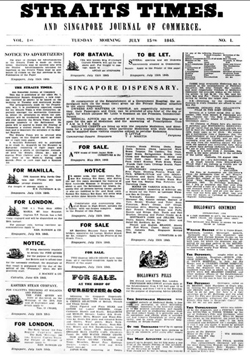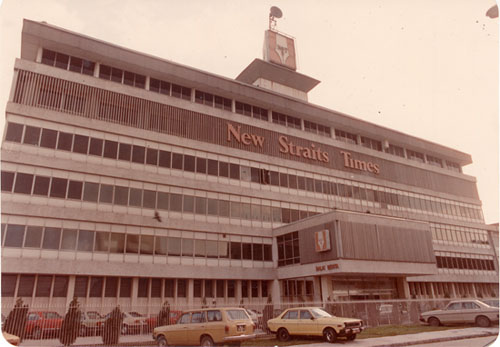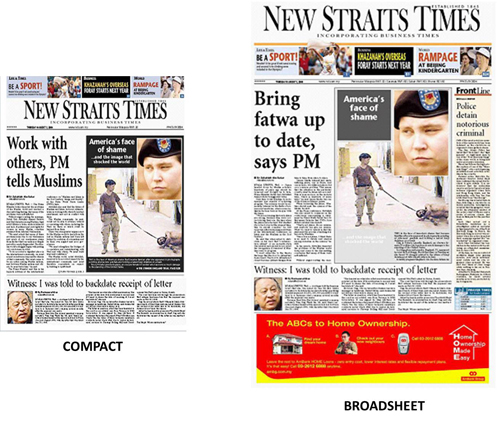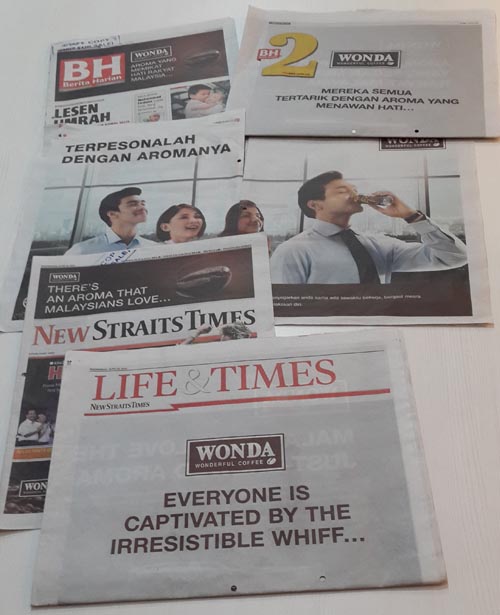
Daily Times reverted to being the Straits Times.
The Straits Times Pte Ltd moved to its own permanent purpose-built premises at Cecil Street, Singapore.
George William Seabridge, who took over from Alexander William Still, increased the size of the paper to 24 pages, changed the format, and enlivened it with pictures, cartoons and caricatures. This was possible with the introduction of two Duplex presses. The presses could fold two eight-page newspapers sections at 5,000 copies an hour.
The Straits Times Press opened an office in London for editorial and advertising services.

The Straits Times copies were carried by mail train for distribution in Kuala Lumpur and Penang.

In July, the Straits Times Press Pte Ltd invested in the first of a fleet of Morris Minor vans to expedite deliveries upcountry.On Dec 20, Malaya’s first Sunday newspaper, the Sunday Times, was launched with a circulation of 10,000. It was printed in the early hours of Sunday morning, for delivery in Singapore and Johor Bahru in time with morning tea, and rushed upcountry in the company’s vans to reach Malacca by mid-morning, Kuala Lumpur by noon, and Ipoh by 6:00 pm.
At the end of 1931, the Straits Times Press Pte Ltd expanded premises and plant facilities and installed the first rotary printing machine.


The Sunday Times resumed publication on Sep 23 with a four-page issue.



The acquisition of the printing business company in the Federation of Malaya, known as The Caxton Press (1957) Ltd to enable the printing of newspaper in Malaya.


The Straits Times Press (Malaya) Berhad moved from Jalan Pudu to Balai Berita, Bangsar.

Web-offset printing press was introduced to replace the rotary letterpress machine. Five units of Goss Metro web-offset were commissioned in Balai Berita, Bangsar in September, followed by another five to cater for the newspaper growth and to print multiple newspapers. It was designed to produce well printed and neatly folded newspapers at a maximum running speed of 60,000 copies per hour to meet the needs of medium and large-sized daily newspapers. It was a flexible press for printing spot colour or full-colour up to 32 pages.
NSTP became a public company and assumed its new name, The New Straits Times Press (Malaysia) Berhad, on Jan 31.
NSTP was listed on the Main Board of the Kuala Lumpur Stock Exchange (KLSE) on Apr 4.

The Company purchased the Photon Mark II Pacesetter, (a microdata photocomposition machine) to replace the traditional hot-metal typesetting. This photocomposition machine was a high speed typesetting machine that produced justified or unjustified text on photosensitive paper or film, at a speed of approximately 90 newspaper lines a minute.
In June, NSTP moved into electronic pre-press operations when the Copy Processing System (CPS) was installed.
The first local financial newspaper called Business Times, a 12-page broadsheet, was published by a wholly-owned subsidiary Financial Publications Sdn Bhd on Oct 4.

In September, the microwave facsimile transmission of page films from Balai Berita, Kuala Lumpur to regional printing plants was introduced.

NST Newspaper in Education (NIE) was launched on Jan 6 by Minister of Education Datuk Abdullah Ahmad Badawi.
NSTP acquired 70% shares in Shin Min Daily News (M) Sdn Bhd – the third largest Chinese language newspaper in Malaysia in June.
Berita Harian’s Akhbar Dalam Darjah (ADD) was launched on Jun 29.
The northern edition of the NST was launched on Nov 4.
On Aug 11, the southern edition of NST was launched, followed by the eastern edition on Oct 17.

On March 25, Harian Metro, the country’s first afternoon Bahasa Malaysia paper, was launched. The price was 50 sen.
Sri Pena, NSTP’s Training centre at Port Dickson, was officially opened to the Group’s employees on Dec 7.
On March 25, the southern edition of Harian Metro was launched in Johor Bahru.
Four members of senior management operating under Realmild Sdn Bhd staged a management buyout which later resulted in MRCB taking over NSTP and STMB (TV3) from Renong Berhad. The buyout exercise was completed on Jun 25.
Launch of Minda Pelajar on Dec 4. 50,000 issues were printed weekly at RM0.70 per issue.
On Aug 1, Harian Metro Edisi Utara was launched.
The first issue of Didik, a weekly education tabloid, was published on Dec 19 with a cover price of RM0.70.

On Aug 19, Metro Ahad was officially launched and the first issue hit the streets the following day.
NSTP ventured into outdoor advertising under NST Outdoor Sdn Bhd.
On Sep 19, Cars, Bikes and Trucks, a weekly pullout in New Sunday Times, was launched.

The KBA presslines in Balai Berita Prai were also commissioned in December.
On Apr 22, official opening of Balai Berita Senai in Johor. Balai Berita Senai is the first of NSTP Group’s four printing plants to be equipped with the new machineries – the Koenig & Bauer Albert (KBA) Commander printing press and Idab Wamac mailroom system. Idab Wamac mailroom system is a sophisticated material handling system, which can automatically insert the preprinted products into the newspaper during printing.
On Jun 28, NSTP entered into a Share Sale and Purchase Agreement with Alaf Positif Sdn Bhd to dispose of its entire 100 % equity stake in Berita Publishing Sdn Bhd. On Oct 9, the Company completed the disposal of Berita Publishing to Alaf Positif.

Malaysian Resources Corporation Berhad (MRCB) on Oct 8, announced a proposed divesting of its media subsidiaries Sistem Televisyen Malaysia Berhad (TV3) and NSTP under a company called Profitune.
On Jun 1, the Business Times was incorporated into NST to give added value to readers of both publications.
On Oct 6, Profitune Bhd changed its name to Media Prima Berhad.
On Oct 22, Media Prima Berhad, a major shareholder of NSTP, was listed on the KLSE in place of TV3, upon completion of the restructuring of TV3 and the reorganization of MRCB.

On Oct 1, NST compact was made available nationwide, followed by NSunT on Oct 3.
On Oct 13, Online advertisement booking system was put in place via http://nstpclassifieds.nstp.com.my, to make it easier for advertisers to place their classified ads.
On Apr 17, the NSunT was printed totally in the new compact version with a new masthead. This was followed by NST the next day, also with a new masthead.
On Jun 6, i-Metro, an interactive portal providing HM readers a chance to be the eyes and ears of their community was launched.

On Aug 27, NSTP 1klassified was published. The bilingual 1klassifieds are available daily in NSTP’s three main newspapers – New Straits Times, Berita Harian and Harian Metro.
On Dec 18, Computer-to-plate (CTP) system was installed and was officially completed on May 27, 2009. Three CTPs were installed as a direct replacement for the three KNF (Computer –To-Film) lines in BBSA for the pre-press plate making process. The CTP shortens the pre-press process flow by eliminating the film process flow (no more films involved in the process). This will eliminate the usage of films and also the chemicals involved to process the films.
On Nov 12, Media Prima Bhd revised upwards its takeover offer for NSTP. MPB announced its proposal to increase the offer price of each NSTP share to RM2.40 from RM2 previously offered.
On Sep 27, the entire issued and paid-up capital of NSTP Berhad was removed from the Main Market of Bursa Malaysia.
The iPad edition for Harian Metro was launched in March, followed by NST in April and BH in July.


Berita Harian launched both its Sabah and Sarawak edition on Jan 8. The regional edition was printed in Kuching and Kota Kinabalu with the aim to speed up the time for the newspaper to be available in the market.
NST produced the first Malaysia’s talking newspaper on Feb 21. A QR code was placed within the articles in the newspaper which enabled readers to listen to a recording of the articles or advertisements.
The digital version of NST, BH and HM was launched on Jun 15 enabling readers to access the newspaper at anytime, anywhere.
Conjunction with its 55th anniversary, a revamp was carried out for Berita Harian. On July 1, Berita Harian name was changed to ‘BH’, an acronym for Berita Harian. The design of the masthead as well as the layout and content of BH were also changed during the revamp.
BH created history by carving a name in the Malaysia Book of Records on July 20 for the longest running entertainment show – Anugerah Bintang Popular Berita Harian 2011.

Harian Metro recorded the highest sales in a day in history by selling 602,005 copies with the issue on May 6. This was a day after the 13th General Election.

On Nov 30, Harian Metro launched its Syok Sabtu Harian Metro initiative as a new, creative way to enhance its role as a reader friendly newspaper with new interesting columns such as MS2- a magazine- style supplement with articles on current lifestyle.
In conjunction with Syok Sabtu’s Launch, Harian Metro also orchestrated a one day contest, Lagi Mudah Menang, offering cash prizes worth RM300,000 for 121 lucky readers.
The Syok Sabtu Harian Metro campaign aimed to sell more than 1.1 million copies of Harian Metro across the nation.
A new pullout, BH2 was introduced in BH daily starting from Jan 13.

On Jan 28, BH unveiled the refreshed look and content of Minda pullout.On May 4, Harian Metro launched a new look for its Metro Ahad. The Sunday paper also featured a new columns; Teropong Jenayah, Zikir Zindagi by Ustaz Haslin Baharim or better known as Ustaz Bollywood and a gossip column Cik Pang. A new pullout Expresi Metro Ahad or MAX was also introduced to reach the youth.
On May 22, NSTP received ‘5S’ certification from Malaysia Productivity Corporation for its printing plant in Bukit Jelutong, Shah Alam. This marked NSTP to officially become the first newspaper publishing company to be ‘5S’ certified.





On March 18, NSTP’s printing plant in Terengganu, Balai Berita Ajil received ‘5S’ certification from Malaysia Productivity Corporation, making it the second newspaper printing plant in Malaysia to obtain ‘5S’ after BB Shah Alam.
This was followed by NSTP’s printing plant in Johor, Balai Berita Senai on March 24 and finally Balai Berita Prai in Penang on March 25.


The NST’s Life & Times pull-out as well as the New Sunday Times had a design revamp, on August 2. The objective was to make it a more organised read with articles on current issues encompassing health, fashion, food, travel, entertainment, education and lifestyle to satisfy reader’s appetite for credible, quality content and information.

On October 21, NSTP launched three free mobile applications, known as NST Mobile, BH Mobile and HM Mobile to provide readers with snappy access to the latest news from its three popular newspapers. Through these apps, readers can easily search for news according to categories such as Malaysian news, world, business, sports, tech as well as lifestyle.

• Dataran Tanjung Emas, Muar, Johor on March 19
• Padang MPK3, Kuantan, Pahang on March 26
• Miri City Fan, Miri, Sarawak on April 16
• Kuching Waterfront, Kuching, Sarawak on May 21



HM was the first in the Media Prima Group to utilise Facebook live services by reporting an accident at MidValley on March 22. FB Live later became an integral tool providing customised content to suit NSTP’s audience.


On May 16, an interactive education portal and mobile application leveraging on Malaysian major examinations; UPSR, PT3 and SPM called FullAMark was launched by the Minister of Education. The ceremony was held at SK Bukit Jelutong Shah Alam.
The portal helps students practice new exercise every week and also make exercise intensively and practically every week. The exercises provided are based on the syllabus and latest assessment set by the Examination Board and prepared by the writers of the educational pullout of BH newspapers- DIDIK, MINDA and SKOR and educational pullout of NST, New School Times.



Mag Street which was launched on September 16, is NSTP’s owned content aggregator platform providing easy and quick access to e-magazine, digital news titles, education portal and mobile apps. It connects readers to comprehensive and attractive digital contents that include entertainment, lifestyle, technology, news, auto and education.
BHTV Capsule was introduced and aired on early September as another digital initiative by NSTP to allow readers to browse and watch videos on special interest topics such as Liga M & Bicara EPL, Jom Tanya Ustaz, Apa Kes?, IQ Didik, Viral and Soal Jawab via BH YouTube and BH Facebook.

In February, NSTP introduced Market Execution Partners (MEP) as part of its continuous business process improvement programme to transform the newspaper copies sales business. Based on the Route-to-Market (RTM) strategy, MEP uses NSTP’s existing vendor network but with an upgraded system that deals directly with few large vendors instead of many smaller vendors previously.





• Special exhibition entitled “BH Khas Hari Kebangsaan” at KL Sentral
• Publication of coffee-table book, “BH: Enam Dekad Kekal Dimensi”
• BH 60th Anniversary Dinner
• Reprint of BH’s 1st edition on Malaysia’s National Day
• Special edition supplement on July 1
• Wakaf BH – a CSR programme for 6 states




June 9 was the launching of the lifestyle portal for women,Hijab & Heels, a digital platform brand by NSTP to bring the latest trends in fashion and lifestyle to Muslim women who wear the hijab. The portal has several sections: beauty and fashion, health and wellness, family and nutrition and recreation.
In August, NSTP created hyper-local FB pages in 14 states in the country to focus on matters and news concerning the local community. The FB pages were handled by the respective State’s bureau chiefs.

Jom Cinta Nabi campaign was introduced to enhance the Muslims’ appreciation toward Prophet Muhammad SAW. The month-long campaign in conjunction with the Maulidur Rasul 2018 was filled with activities in both Print and Online:
Print– publication of articles and essays on Sirah, Sahsiah and Sunnah and exclusive Jom Cinta Nabi poster
Online– Jom Selawat contest, videos, news and special BHTV capsule, Jom Tanya Ustaz Edisi Khas: Jom Cinta Nabi.

During an extraordinary general meeting in November, Media Prima Berhad received 99.8 percent of the shareholders’ votes for the sale and leaseback of its properties with PNB Development Sdn Bhd. The properties included Balai Berita Shah Alam and Balai Berita Bangsar for a total cash consideration of RM280 million. Upon completion of the sale, the group recorded a gain of RM133.1 million.
On February 18, KDYMM SPB Yang di-Pertuan Agong XVI Al-Sultan Abdullah Ri’ayatuddin Al-Mustafa Billah Shah graced the Monarch exhibition held at Galeri Prima, Balai Berita Bangsar. His Royal Highness was accompanied by KDYMM SPB Raja Permaisuri Agong Tunku Hajah Azizah Aminah Maimunah Iskandariah. The exhibition, which showcased more than 80 photograph images and news clippings from the installation of the first Agong in 1957 to the swearing-in of Al-Sultan Abdullah on Jan 31. The royal couple also visited the three NSTP editorial offices: BH, NST and Harian Metro.
BH celebrated its 62nd anniversary on July 1 by introducing a new tagline, Wadah Pembaharuan – Berimbang, Adil & Tepat. The idea behind this tagline was to adapt the digital era as well as delivering the “Malaysia Baharu” concept by focusing more on issues of public interest and efforts to develop the country to be a successful nation.
The Segerak VIII: Utopia exhibition was officially launched by DYMM Sultan of Perak, Nazrin Muizzuddin Shah Ibni Almarhum Sultan Azlan Muhibbuddin Shah Al- Maghfur-Lah on August 1 at Galeri Prima, Balai Berita, Bangsar. It consisted of 30 masterpieces of artwork by Yusof Ghani, a renowned Malaysian artist. The royal couple also visited the three NSTP editorial offices: BH, NST and Harian Metro.
Harian Metro introduced its revived edition on September 16 with the objectives of rebuilding its brand awareness, retaining the existing market as well as capturing the new market. Among the new features were Akademia, Wanita Metro (WM), #ITMetro and P&P (Pemaju dan Pemilik).
The Bantuan Metro Prihatin, a charity fund under the MPB-NSTP Humanitarian Fund was officially launched by the Deputy Prime Minister YAB Dato’ Seri Dr. Wan Azizah Dr. Wan Ismail on November 18 at Balai Berita Bangsar. The fund is an extension to the popular Metro Prihatin column highlighting the plight of underprivileged communities. The establishment of such a fund would make it easier for readers to contribute and allow HM to be more transparent and systematic in handling the distribution.











